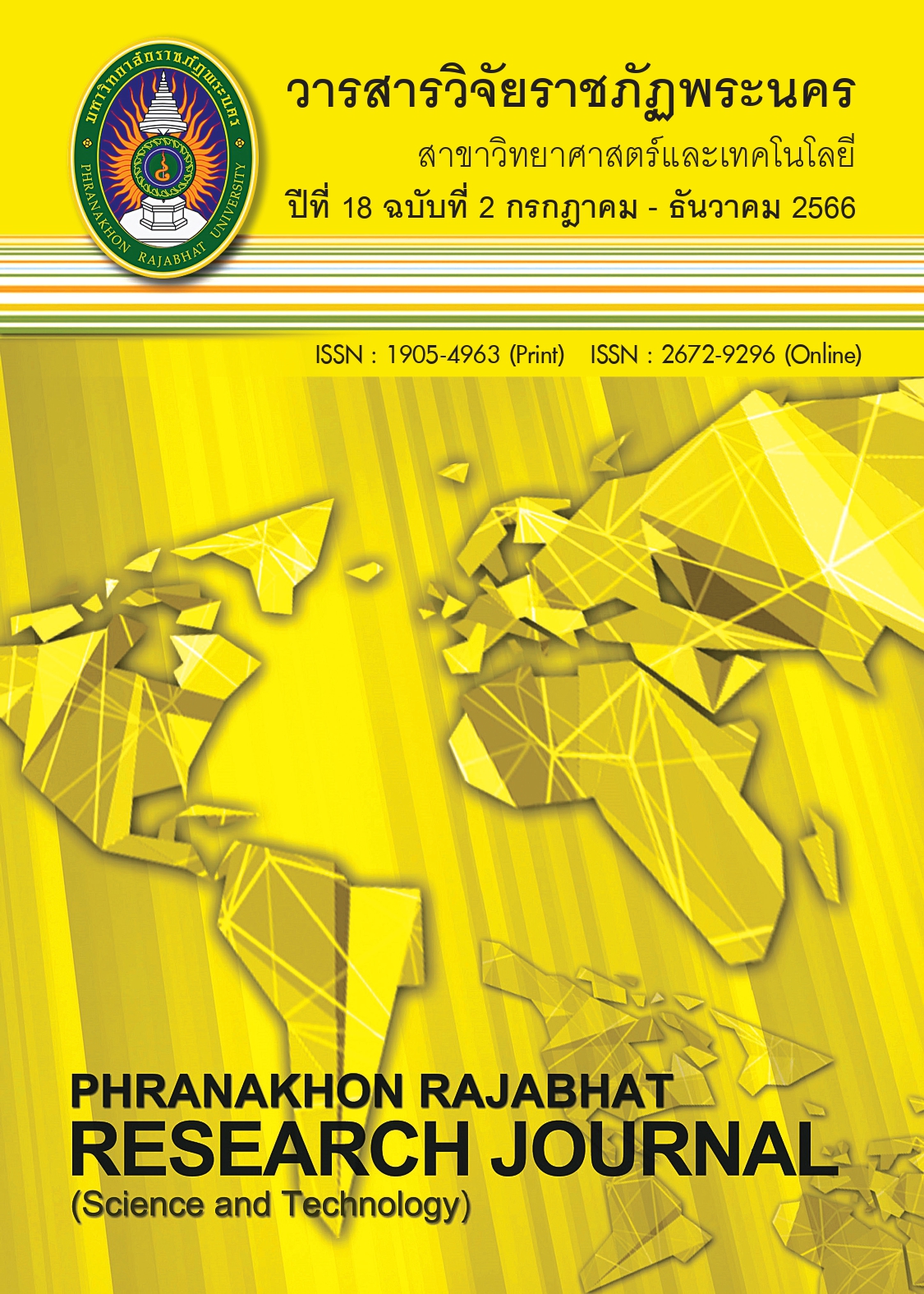MEASURING THERMAL CONDUCTIVITY OF MATERIALS BASED ON THERMOELECTRIC EFFECT
Keywords:
Thermal Conductivity, Thermoelectric Effect, Peltier Effect, Seebeck Effect, Thermoelectric ModuleAbstract
This work aims to develop an apparatus for measuring the thermal conductivity of bulk materials based on the steady-state method, employing a thermoelectric module (TEM). The cost-effective and easily accessible TEMs were utilized as the heating source, cooling source, and heat flux meter. The TEM was used to generate heating and cooling on the basis of the Peltier effect, which involves the conversion of electricity into thermal energy. On the contrary, the Seebeck effect, based on the direct conversion of thermal energy into electricity, was employed as the principle for creating a heat flux meter. To generate heating or cooling, four TEMs, each with dimensions of 4.0 × 4.0 cm2, were connected in a parallel circuit to form the heating and cooling sets. Each set was in direct contact with a copper heat exchanger plate, creating a sandwich model with an 8.0 × 8.0 cm2 sample material placed in the middle. A TEM was embedded in the copper plate near the heating set to measure the heat passing through the sample surface. To validate the accuracy of this apparatus, the thermal conductivity value of a polystyrene foam, which was tested according to ASTM C518, was compared with the value obtained by using an apparatus developed in this work. The results indicated that this apparatus achieved high accuracy, with an average error of 0.87%.
References
ASTM C117. (2002). ASTM C177-97 Standard test method for steady-state heat flux measurements and thermal transmission properties by means of the guarded-hot-plate apparatus. Annual Book of ASTM Standards, 4(6), 21-32.
ASTM C518. (1998). ASTM C518 Standard test method for steady–state heat flux measurement
and thermal transmission properties by means of the heat flow meter apparatus. Annual Book of ASTM Standards, 4(6), 163-174.
Ajiwiguna, T.A. & Kim S.Y. (2016). Thermal conductivity measurement using thermoelectric
module. Journal of Physics: Conference Series, 8(776), 1-4.
Chinnaboon, P. (2012). University physics 1. Bangkok: Witthayaphat. 240-243. (In Thai)
Du, B. X., Kong, X. X., Li, J., & Xiao, M. (2019). High thermal conductivity insulation and sheathing
materials for electric vehicle cable application. IEEE Transactions on Dielectrics and Electrical Insulation, 26(4), 1363–1370.
Dubois, S. (2013). Design construction and validation of a guarded hot plate apparatus for thermal conductivity measurement of high thickness crop-based specimens. Materials and Structures, 48, 407-421.
Feofanov, S.A. & Chashchin, S.L. (2021). Thermoelectric modular systems based on
semiconductor elements of Peltier-Seebeck for vehicles. Journal of Physics: Conference Series, 2061, 012015.
Harun, M.H., Azmi, M.W.N., Aras, M.S.M., Azlan, U.A., Azahar, A.H., Annuar, K.A.M., Halim, M.F.M.A.,
Yaakub, M.F. & Abidin, A.F.Z. (2018). Study on the potential of peltier in generating electricity using heat loss at engine and exhaust vehicle. Journal of Advanced Research in Fluid Mechanics and Thermal Sciences, 49(1), 77-84.
Khaothong, K. (2019). Experimental setup for measuring thermal conductivity of architecture
fabrics. The Engineering Institute of Thailand under H.M. The King’s Praronage, 31(1), 145-154. (In Thai)
Kraemer, D. & Chen, G. (2014). A simple differential steady-state method to measure the thermal
conductivity of solid bulk materials with high accuracy. Review of Scientific Instruments, 85(2), 025108.
RDI-SNRU. (2019). Thermoelectric technology. Retrieved from
B9%89%E0%B9%84%E0%B8%82.pdf [2023, 6 Apr.]
Reddy, K.S. & Jayachandran, S. (2016). Investigations on design and construction of a square
guarded hot plate (SGHP) apparatus for thermal conductivity measurement of insulation
materials. International Journal of Thermal Sciences, 120, 136-147.
Rincon-Tabares, J.S., Velasquez-Gonzalez J. C., Ramirez-Tamayo, D., Montoya, A., Millwater, H. &
Restrepo, D. (2022). Sensitivity analysis for transient thermal problems using the complex-variable finite element method. Applied Sciences, 12(5), 1-23.
Sánchez-Calderón, I., Merillas, B., & Bernardo, V. (2022). Methodology for measuring the thermal
conductivity of insulating samples with small dimensions by heat flow meter technique. Journal of Thermal Analysis and Calorimetry, 147, 12523–12533.
Seetawan, T. (2015). Thermoelectric technology. Bangkok: Chulalongkorn University Printing
House. (In Thai)
Tananchai, T. (2014). Design and construction of an experimental set to determine the
coefficient of thermal conductivity of materials. (Master of Science). Burapha University. (In Thai)
Thongchainumchok, K., Phutthaheng, W., Kirdsiri, K., & Srisittipokakun, N. (2022). Development of
thermal insulator from sugarcane leaves. In W. Pinkeaw (Ed.), The 14th NPRU National Academic Conference. Nakhon Pathom: Research and Development Institute. 313-317.
Umnyakova, N. (2020). Thermal protective qualities of the combined material with reflective
thermal insulation from aluminium foil. In N. Vatin (Ed.), IOP Conference Series: Materials Science and Engineering, 896, 012018.
Yüksel, N. (2016). The review of some commonly used methods and techniques to measure the thermal conductivity of insulation materials. In A. Almusaed (Ed.), Insulation Materials in Context of Sustainability. 113-140.
Zhang, J., Kutlu, S., Liu, G., & Tansu, N. (2011). High-temperature characteristics of Seebeck
coefficients for AllnN alloys grown by metalorganic vapor epitaxy. Journal of Applied Physics, 110(4), 043710.
Downloads
Published
Issue
Section
License

This work is licensed under a Creative Commons Attribution-NonCommercial-NoDerivatives 4.0 International License.
โปรดกรอกเอกสารและลงนาม "หนังสือรับรองให้ตีพิมพ์บทความในวารสารวิจัยมหาวิทยาลัยราชภัฏพระนคร สาขาวิทยาศาสตร์และเทคโนโลยี" ก่อนการตีพิมพ์




